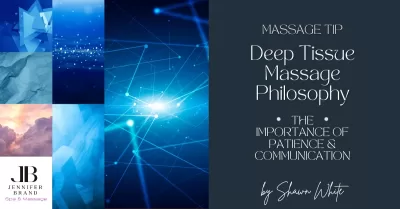Organized Massage
Develop an Organized Massage
At the core of every magnificent massage is an organized approach. We need to have a plan built from our client’s goals. Every technique utilized must have a reason for why it is being used, and the person we are touching must remain our sole focus. Today we are going to discuss a handful of ways you can provide a massage that feels organized.
When teaching someone new to massage I advocate for them to use the Rule of Three. This means every technique must be applied three times. This helps them keep track of the number of times they have used a technique.

New therapists tend to haphazardly use a movement too many times in succession. This may cause the client to become annoyed; it may aggravate their nervous system or even reduce the quality of the session. In other instances, a therapist may use a technique less than they should. This is unfortunate because a client may not even notice the value of a technique being applied until the second or third application. The Rule of Three provides people enough time to notice and vocalize whether the sensation. Any time a client indicates the technique feels exceptionally good, a therapist should double the number of times they perform it. Additionally, the Rule of Three ensures the massage has balance. Balance indicates each technique was utilized equally on both sides of the body. This is important because an unbalanced massage may cause discomfort after and during the session.
Balance is a central component to an organized massage. It shows the client you have a plan of action and care about the quality of their experience. Sometimes balance doesn’t matter, this is typically when we are only massaging one area of the body.
Another method of providing a well-organized massage session is through the use of my Timing Technique. My Timing Technique is designed to provide a thorough and even application of bodywork throughout a massage session. Implementing it requires planning. You will need to divide the body into segments and subsegments. For example, the upper leg would be one segment. Then, depending on the goals of the client, I may divide the upper leg into 2-4 subsegments. Each subsegment is allotted a specified number of seconds for the area to be massaged. Typically, I will use increments of 10,15, 30, and 60 seconds.
Another method I encourage practitioners to use is micro formulas. A micro formula is a collection of massage techniques used in sequence. This is valuable because it helps a therapist keep track of each technique used, improves the balance of a session and encourages harmony.
Harmony is the client’s perception of your touch, and it is determined by the type of massage techniques, methods, and styles you use throughout the session. If your techniques, methods and styles are vastly different from each other it will feel chaotic. Chaos is stressful and is the opposite of the healing experience most people seek in a massage. A massage is meant to be organized and orderly. The client wants to have confidence in your touch. If they believe you are randomly applying techniques like the ingredients of potpourri, it will fail to achieve the stress-relieving experience they seek.
Experience the ease, comfort and serenity you need at Jennifer Brand Spa. Feel the outside world float away as your senses are soothed, replenished and revitalized. Discover how it feels to be the center of the universe, to live with harmony, and embrace peace.

Deep Tissue Massage Philosophy
Deep Tissue Massage Philosophy Massage Tip Today we are going to dive into Deep Tissue Massage Philosophy. Deep Tissue massage can be a majestic experience, especially for those who are seeking corrective [...]
Sensations
The Sensations of Massage Massage Tips about Sensations When receiving a massage, uncomfortable sensations are often divided into two main categories, “hurts so good”, and “ouch that hurts”. If the sensation is [...]
Pain Management
Pain Management Massage Tips about Pain Management Massage can be a great pain management tool. It can be beneficial whether it is from inexperienced hands or even a licensed massage therapist. One [...]



